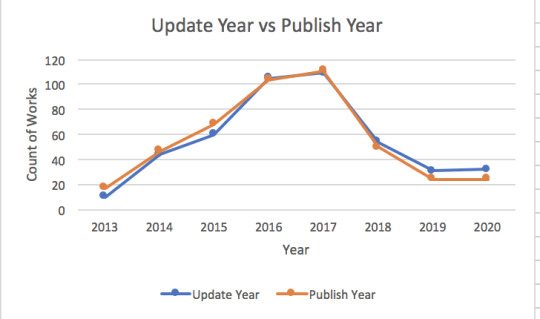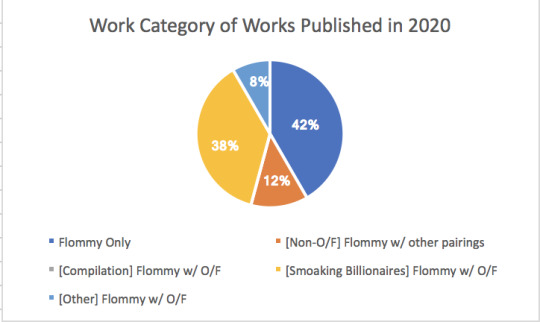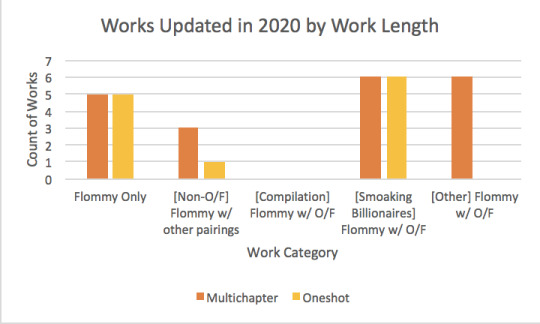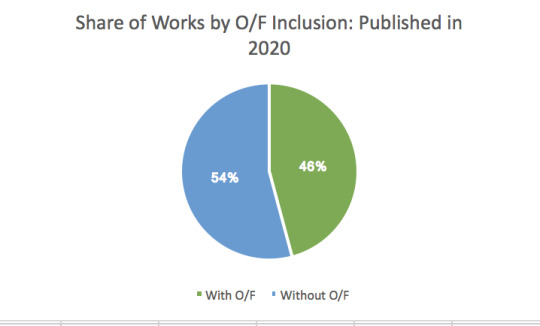#em needs to stop indulging in random hyperspecific research projects that amount to nothing important for fun
Text
It’s... maybe a little strange that I have a “comfort” Excel workbook and dataset for which I make charts/graphs to unwind from work sometimes.
#em needs to stop indulging in random hyperspecific research projects that amount to nothing important for fun#because a year an a half later here I am again working on TGFTA#and somehow finding all new charts and data combinations to make
2 notes
·
View notes
Text
Because I’m that much of a completionist...

Part 4: 2020 Year in Review
[Part 1] [Part 2] [Part 3]
Introduction
For anyone who missed my fit of data-collection madness (for fun!) in August, I gave into my own curiosity and combed the entire Flommy tag on AO3 to take a look into various trends over time, how the tag breaks down in terms of ship categories, etc. Since I took on the project when the year was slightly more than half over, any data collected for 2020 was year-to-date (YTD) and as such incomplete, compared to previous years. This fact (combined with how attached I’d already grown to my spreadsheet for this study) got me to consider adding a 2020 end-of-year wrap-up datapost. Now that 2020 is finally getting kicked out the door, let’s take a look at how the year shaped up for Flommy works!
Methodology
As noted in Part 1, the overarching goal of the study was to examine and catalogue the contents specifically within the “Tommy Merlyn/Felicity Smoak” relationship tag on Archive of Our Own. All works featured in these results are tagged as (or otherwise wrangled under) this relationship tag; though it’s doubtful that this is the case, any works featuring this relationship that are not tagged in this way (and thus do not appear) will not be counted.
By final data collection on December 31, 2020, there are 445 works total (inclusive of hidden works viewable and accessible only with an AO3 login) within the Flommy tag. (For context, there were 441 works for the earlier parts of this study that examined 2013 through 2020 YTD, the data for which was collected on August 5.) Measures defined in Parts 1 and 2 of this study still apply; however, the following category has been added with this installment:
Creator Seniority: denotes whether or not a creator has previously published a work within the Flommy tag
First-Year Flommy Creators are those who first posted in the tag in the year in question; creators may post multiple works in their first year and will still be counted in this category until the following year(s)
Existing Flommy Creators are returning creators to the tag, having posted their first work(s) in an earlier year
Publish Year and Update Year
Let’s start by taking a look at these charts again, to see how 2020 Full Year netted out compared to previous years. Both the Publish Year (accounting for all works published within a given year) and Update Year (the most recent year in which a work was updated, which also includes the works published that year) are depicted here, as they make similar shapes overall, but with some slight differences:

The key change here from the original Part 1 chart is 2020, but the full timeline helps to provide context. Back in August, 2020 was still tracking under 2019′s work count for both works published and works most recently updated; in terms of Publish Year, 2020 YTD had a -21% decrease in published works over the previous year. By year’s end, though, there were exactly as many works published in 2020 as there were in 2019, and a one-work increase for Update Year! While not the significant YOY increases in the early years of the tag, it also isn’t the steep declines as of late--holding steady is a good sign, given series’s end and the fact that this is becoming an even rarer pair as time goes on.
Some other Publish and Update Year Fun Facts:
Of the works updated in 2020, 25% were from an earlier Publish Year (the remaining 75% were all published in 2020)
At least one work published each year between 2015 and 2019 was updated in 2020, with 2018 holding the most previously published works updated this year
Creator Seniority
2020 seems like a good year to give our newest measure a test drive:

This year saw a fair amount of new Flommy creators contributing to the tag (myself included, to be honest), accounting for just over 2/3 of the total individual creators who published at least one work in 2020. I may put up previous years’ breakdowns for comparison as supplemental material, but even 2020 in isolation tells an interesting story--that despite the end of the series, new creators have stories to tell within this rare pair tag.
(Granted, as noted in Part 2 with the breakdown of Relationship Tagging, there is a potential that some works were improperly tagged as romantic [/] that should be platonic [&], or feature Flommy in a minor capacity, but categorization beyond that would be more qualitative and subject to researcher bias.)
Some other Creator Seniority Fun Facts:
Though the majority of creators in the tag are First-Year Flommiers, 58% of the works published in 2020 were by Existing Flommy Creators
All new creators published one Flommy work in 2020, while some returning creators contributed multiple offerings
Share of Work Category
We’ll look first at Publish Year, then Update Year, for where the works fall by relationship tagging:

2020 did not yield any new [Compilation] works (AKA works tagged for both Flommy and O/F, but which are meant as prompt collections, ficlets, etc. where pairings differ by installment), nor were any updated, so we’ll only be focusing on the remaining four categories for these charts.
In a delightfully surprising turn, the majority of all new works were tagged as [Flommy Only] (works with no other romantically-tagged relationships)! This is cool to see, knowing that there are still new works coming specifically for these two. [Smoaking Billionaires] (tagged for the other pairings of the OT3 and/or indicative that it’s an OT3 and not a love triangle) follows as a close second, and interestingly, there were very few [Other] (tagged for both Flommy and O/F, but are not ficlet compilations or OT3--i.e. love triangles, potential platonic/familial tagging errors, etc.) works published in 2020.
But that’s just the works published in 2020: let’s take a look at the story when we factor in the works updated as well:

The percentages for two of our categories haven’t changed at all, but now [Other] has taken a bit of share from [Flommy Only], knocking the latter out of the top spot. [Other], indeed, was the category with the most works from previous years that were updated in 2020, which made up ground for the category since there weren’t many newly published works. By contrast, [Flommy Only] works were solely from 2020--no previous works were updated, which decreased its Update Year share.
Work Length and Completion Status
We’ll stick with Update Year for these, to get an idea of all the works that had new material added in 2020.

There are some interesting patterns with our work categories! The top two--[Smoaking Billionaires] and [Flommy Only]--are both split 50/50 between Multichapter and Oneshot, so both work lengths have had fair representation for these two categories. [Other], meanwhile, is the sole category whose 2020 contributions were entirely Multichapter works. As that’s a more nebulous category in terms of Flommy-tagging, there could be an interesting story there, but that’s again beyond the quantitative measures used here.
Now for Completion Status:

Interestingly, while both [Flommy Only] and [Smoaking Billionaires] had the 50/50 split for Work Length, at least half of each of their Multichapter works are marked as Complete on AO3. [Non-O/F], on the other hand, matches back to the Work Lengths perfectly, with all Multichapters still Ongoing and only the Oneshot marked as Complete. Our [Other] category, entirely comprised of Multichapter works, shows that just under a third of them are Complete.
Additional Relationships
Wrapping up the year-in-review with one last measure, which closed out Part 1 and the bonus Part 3--the comparison of works also tagged for Oliver/Felicity to those without:

This serves as a narrowing down of the existing Work Categories--[Smoaking Billionaires] and [Other] are rolled into the “With O/F” category, and [Flommy Only] and [Non-O/F] are rolled into the “Without O/F” one--and reflects the Publish Year data.
Compared to the full 2013-2020 YTD charts shared previously, where the “With O/F” category held the majority, if we isolate 2020 on its own, the “Without O/F” category edges out the win by a slight margin. This is a notable feat, as I examined the splits for previous years, and not only did “With O/F” come out on top every year, it was by a considerable difference (the closest split was all the way back in 2014, where 62% of the works were “With O/F” and the remaining 38% “Without O/F”). 2020 is the first and only year so far to turn the tables, at least in terms of newly published works.
Conclusion
And with that, The Great Flommy Tag Analysis 2020 comes to a close! I admittedly have assorted other measures that weren’t previously included in dataposts that could make an appearance if there’s interest, but with this 2020 year-end wrap-up, that’s the end of the planned data analysis. Hopefully this served up a couple interesting bits of info, word- and chart-heavy as this study wound up being.
#The Great Flommy Tag Analysis 2020#flommy#em needs to stop indulging in random hyperspecific research projects that amount to nothing important for fun
2 notes
·
View notes